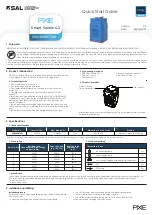
• To provide more port security on ports that are directly connected to an FCF and have links to other FIP
snooping bridges, set the FCF or Bridge-to-Bridge Port modes.
• To ensure that they are operationally active, check FIP snooping-enabled VLANs.
• Process FIP VLAN discovery requests and responses, advertisements, solicitations, FLOGI/FDISC requests
and responses, FLOGO requests and responses, keep-alive packets, and clear virtual-link messages.
FIP Snooping in a Switch Stack
FIP snooping supports switch stacking as follows:
• A switch stack configuration is synchronized with the standby stack unit.
• Dynamic population of the FCoE database (ENode, Session, and FCF tables) is synchronized with the
standby stack unit. The FCoE database is maintained by snooping FIP keep-alive messages.
• In case of a failover, the new master switch starts the required timers for the FCoE database tables.
Timers run only on the master stack unit.
Using FIP Snooping
There are four steps to configure FCoE transit.
1
Enable the FCoE transit feature on a switch.
2
Enable FIP snooping globally on all Virtual Local Area Networks (VLANs) or individual VLANs on a FIP
snooping bridge.
3
Configure the FC-Map value applied globally by the switch on all VLANs or an individual VLAN.
4
Configure FCF mode for a FIP snooping bridge-to-FCF link.
For a sample FIP snooping configuration, refer to
FIP Snooping Configuration Example
.
Statistical information is available for FIP Snooping-related information. For available commands, refer to the
FCoE Transit
chapter in the
Dell Networking OS Command Line Reference Guide
.
FIP Snooping Prerequisites
Before you enable FCoE transit and configure FIP snooping on a switch, ensure that certain conditions are
met.
A FIP snooping bridge requires data center bridging exchange protocol (DCBx) and priority-based flow
control (PFC) to be enabled on the switch for lossless Ethernet connections (refer to the
chapter). Dell Networking recommends also enabling enhanced transmission
selection (ETS); however, ETS is recommended but not required.
If you enable DCBx and PFC mode is on (PFC is operationally up) in a port configuration, FIP snooping is
operational on the port. If the PFC parameters in a DCBx exchange with a peer are not synchronized, FIP and
FCoE frames are dropped on the port after you enable the FIP snooping feature.
For VLAN membership, you must:
FIP Snooping
382
Summary of Contents for S4048T
Page 1: ...Dell Configuration Guide for the S4048T ON System 9 10 0 1 ...
Page 98: ... saveenv 7 Reload the system uBoot mode reset Management 98 ...
Page 113: ...Total CFM Pkts 10303 CCM Pkts 0 LBM Pkts 0 LTM Pkts 3 LBR Pkts 0 LTR Pkts 0 802 1ag 113 ...
Page 411: ...mode transit no disable Force10 Resilient Ring Protocol FRRP 411 ...
Page 590: ...Figure 67 Inspecting the LAG Configuration Link Aggregation Control Protocol LACP 590 ...
Page 646: ...Figure 87 Configuring Interfaces for MSDP Multicast Source Discovery Protocol MSDP 646 ...
Page 647: ...Figure 88 Configuring OSPF and BGP for MSDP Multicast Source Discovery Protocol MSDP 647 ...
Page 653: ...Figure 91 MSDP Default Peer Scenario 2 Multicast Source Discovery Protocol MSDP 653 ...
Page 654: ...Figure 92 MSDP Default Peer Scenario 3 Multicast Source Discovery Protocol MSDP 654 ...
Page 955: ...Figure 119 Single and Double Tag First byte TPID Match Service Provider Bridging 955 ...
















































